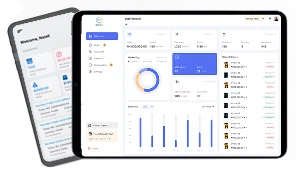
Warehouses face all sorts of challenges that are not easy to resolve. However, these problems must be addressed on a priority basis to avoid losing money and customers.
Hence, warehouse managers and workers should strive to implement best practices and warehouse management software that streamlines operations. These are the lowest-hanging fruit that will yield quick results without a major investment. These options are simpler and cheaper compared to deploying automation equipment, which entails heavy upfront costs and high complexity.
In addition to showing key challenges observed in the warehouse, we will also point out simple strategies to mitigate these issues.
Table of Contents
Top 10 Warehouse Challenges and Their Solutions
Here are the 10 main warehouse challenges and how you can resolve them.

1. Spreadsheets and Legacy Systems
Many warehouses still use spreadsheets. However, one thing is becoming increasingly clear. Spreadsheets just don’t work well for anything beyond the smallest operations.
Small businesses in particular still rely on spreadsheets because their ease of use and seemingly good efficiency (for limited operations) give a false sense of confidence. However, this false confidence evaporates quickly as SKU and order volumes grow. Spreadsheets soon become chaotic, and finding information that lives in multiple spreadsheets turns into a nightmare.
Also, integrating spreadsheets with other business systems isn’t easy. Updating spreadsheet data automatically in real-time is difficult, if not impossible.
So warehouse managers should make the right move by leaving behind spreadsheets and embracing advanced inventory software like WareGo that is designed from the ground up for growing SKU/order volume, real-time tracking, and automatic updates.
Our friendly experts can explain how WareGo streamlines your business.
Start My FREE Consultation!2. Inventory Control
Controlling and managing inventory still remains a top challenge for warehouses, especially when order volumes and SKU levels grow.
Inventory needs to be arranged intelligently in the warehouse to facilitate fast picking. For example, high-demand items should be kept closer to workers, while low-demand items can be kept deeper inside. This is a key element of ABC classification.
In addition, you need serialization to track individual items by assigning unique codes to them. This matters especially for high-cost items and where traceability is critical for compliance and recalls.
Other methods are also needed, like slotting, for instance, to quickly retrieve needed items accurately.
Proven inventory management methods and best practices greatly simplify inventory processing.
While these can be done manually, such processes can be very tedious and time-consuming. Hence, they are best done by means of specialized software that has built-in support for proven industry methods and best practices like ABC classification, serialization, slotting, and so on.
3. Warehouse Visibility
Incomplete visibility over the warehouse can create a blind spot when small problems pile up – these problems grow over time, are time-consuming, and eat into productivity. For example, even if a few items are misplaced and no one notices, then order fulfillment will be delayed when customers order these items. Workers will then waste precious time hunting for these misplaced items. This will hurt productivity and slow down order fulfillment for other customers.
Specialized supply chain software grants you complete visibility over warehouse operations via real-time tracking and multilocation management.
WareGo provides complete traceability down to individual items so that your staff knows exactly where each item is placed. There won’t be search operations for misplaced items that hurt productivity and the order fulfillment rate.
Our friendly experts will explain what you need to know.
Chat With Us!4. Stockouts
Stockouts are the result of low visibility, lack of real-time updates, and manual methods. Spreadsheets and outdated legacy systems don’t have the necessary real-time functionality to update stock data with each transaction (like sales or purchases). Hence, item levels can be depleted without anyone noticing until it’s too late.
Advanced systems like WareGo have real-time tracking features so you can follow every SKU with ease.
5. Returns Processing
Returns processing is an inevitable reality of any business that deals with inventory. It is particularly strong in ecommerce since increasingly fickle customers return items just because they can.
Returns processing is therefore necessary to avoid losing customers to the competition. That said, reverse logistics can impact warehouse productivity. Plus, it does not generate immediate revenue in the short term (though in the long term, it clearly pays dividends by retaining customers).
Hence, automated returns processing is the need of the hour for entities that want to survive and thrive in a highly competitive environment where customers are free to leave you for countless other brands on a whim.
An enterprise-level WMS like WareGo incorporates comprehensive returns management so you can maintain high warehouse productivity despite items being returned by customers.
Quick and accurate returns processing lets you retain customers and improve brand loyalty.
6. Organizing Data for Analysis
With data strewn across spreadsheets, business systems, ecommerce platforms, and whatnot, gathering data in one place is still an uphill task for many businesses.
This is a big problem, since data needs to be gathered and organized in one place for deep analysis that leads to great data-driven decisions.
Data silos and disconnected systems prevent business leaders from seeing the full picture. It is much harder in this case to find valuable insights that grow the business.
WareGo resolves this problem by serving as the single source of truth for your inventory data. Plus, the system has 200+ integrations to sync inventory data with popular business systems like ERPs, CRMs, accounts, and others.
Hence, WareGo is the perfect answer for organizing data to facilitate analytics and data-driven decisions for insights that will take your business to the next level.
Book your free demo to understand more.
Start My FREE Demo!7. Manual Data Entry
Inventory data is required not just by the WMS, but also by other business systems like the ERP, CRM, accounts, and others. In the absence of integration, manual methods are needed to transfer this vital data to other business systems. Manual data entry is tedious, slow, and error-prone.
Cutting-edge WMS solutions can free up your staff from endless hours of data entry thanks to integrations that connect the WMS software with other business systems to share inventory data automatically without human intervention.
8. Overstocking
Overstocking is a major problem that consumes limited warehouse space and skyrockets expenses with high holding costs and unsold goods.
While you do need enough inventory to fulfill demand, going too low risks stockouts; hence, minimizing overstocking can be tricky.
Accurate forecasting is a powerful method of controlling this issue. Forecasting software now uses AI-powered tools to analyze previous demand patterns, seasons, trends, safety stock, and other factors to give you the most reasonable forecast.
Manual forecasting can be time-consuming and error-prone. But forecasting via specialized warehouse solutions like WareGo lets you save time, money, and effort while providing more accurate forecasts.
9. Multichannel Sales
While multichannel ecommerce sales can boost sales, managing inventory spread across multiple online and physical sales channels can be very complex. Hence, problems like inventory discrepancies, stockouts, and errors are common. That is why you need a specialized solution with seamless integrations to update inventory in each sales channel automatically in real time.
WareGo has integrations for popular ecommerce platforms and online marketplaces like WooCommerce, BigCommerce, Shopify, eBay, Walmart, Amazon, and others. Inventory on these channels is all synchronized with WareGo, thereby enabling automatic inventory updates, which keep your data accurate, complete, and updated at all times.
Is WareGo right for your business? Our 100% FREE trial can answer this.
Start My FREE Trial!10. Multilocation Management
Running multiple warehouses is a complex task, to say the least. Amazingly, spreadsheets are still widespread and see extensive use in supply chain control.
Due to problems with scalability, lack of real-time updates, and automation, spreadsheets are not the ideal choice for supply chain control, specifically, managing multiple warehouses. The same goes for legacy systems that don’t update in real-time.
Modern supply chain software solutions specifically have multilocation management as a key feature to adequately control your supply chain. WareGo provides you with an easy-to-use console that shows summarized and granular data for all warehouses so you can stay on top of your supply chain.
Bottom Line
While there are multiple warehouse challenges, overcoming them is possible with the right tools and best practices. Opting for a viable warehouse solution instead of spreadsheets and legacy systems is a key step in the right direction.
Virtually all warehouse challenges can be overcome or at least mitigated with a proven warehouse software solution at the core of your warehouse activities.
Find the most affordable rates in our price plans.
Check price plans!FAQs
What are the challenges faced in the warehouse?
Challenges faced in the warehouse include legacy software/spreadsheet problems, poor inventory control, lack of visibility over operations, stockouts, returns processing problems, data silos and disconnected business systems, manual data entry, and overstocking.
These problems may be fully resolved or strongly mitigated with the use of proven software solutions like WareGo that are engineered from the ground up to eliminate these common warehouse issues.
What are the four 04 major challenges in inventory management?
The 4 major challenges in inventory management include stockouts, overstocking, misplaced items, and poor SKU organization/placement on the warehouse floor.
WareGo provides all necessary features to resolve these and other key warehouse problems.
Which is the major issue faced by warehouses?
Inaccurate forecasting is a major problem faced by warehouses because it can lead to excessive stock levels, which result in high holding costs and losses from unsold goods. It can also cause understocking, which leads to stockouts, lost sales, and customer dissatisfaction.
WareGo’s AI-powered forecasts study your previous demand patterns to factor in seasons, supplier lead times, and other key variables to maintain lean inventory levels and optimal safety stock.
What are the common problems to solve in inventory management?
The common problems to solve in inventory management include overstocking, understocking, stockouts, misplaced items, poor inventory placement, order processing errors, and low labor productivity, to name a few.
WareGo elegantly resolves these issues with cutting-edge features that take your warehouse performance to the next level.





